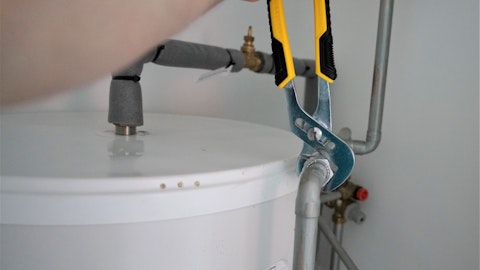Stephen Kim: So, within plumbing, there’s not a particular, let’s say, way of talking about it, that sub — segment or segments out, maybe by country or sort of price point or something like that, where you’re a little bit further away from your goal within that segment.
Keith Allman: Well, there’s not a whole lot of variability when we look geographically and we look at margin variability on a product-type basis. We look at margin variability based on the raw component makeup of the products. We look at margin variability across channels. So that’s all part of our operating system that we used to drive improvements. but we’re not going to break it out specifically by those components as we talk here.
Stephen Kim: Okay, that’s fine. Regarding overall, your improved margin, you talk about cost savings and some of those, I think you highlighted, there’s a little bit of raws that are starting to come to you as a benefit. And then you have freight, which you called out as well. But you’ve also talked about other productivity initiatives and so forth. So, I’m curious as we look into, let’s say, the fourth quarter, if you were to sort of segregate out things like freight and price over raws, how much is, would you say, related to productivity, like things that are more sort of permanent cost-saving efforts that you’ve made, I mean, would you put that in the 10 to 20 basis-point range overall? Or, I mean, is it — just if you can help us understand what some of those initiatives have been adding, or are expected to add here maybe in the fourth quarter, or if you want to talk the full year or whatever?
David Chaika: Hey, Steve. we have made very nice improvements on the productivity line. Recall we had some inefficiencies in the back half of ‘22, particularly in plumbing that we’ve done a very nice job getting on top of. I’d say in terms of bucketing the biggest drivers clearly getting our price cost relationship back to where it should be throughout this year. So, we’ve had very nice cost recovery this year since we did lag it a bit last year. So that’s the biggest bucket. The productivity is a nice tailwind to help with that, but the biggest bucket is the price cost recovery.
Stephen Kim: Okay. thanks very much, guys.
Keith Allman: Thanks, Steve.
Operator: Our next question comes from the line of Truman Patterson of Wolfe Research. Please go ahead.
Truman Patterson: Hey. good morning, everyone. Thanks for taking my questions. Keith, just wanted to follow up. You mentioned that brass deflation for the year should kind of run in the down low single-digit percentage. Should we assume that was likely inflationary in kind of the first quarter and perhaps the fourth quarter is trending down maybe in the mid-single-digit percentage or better range as we said today?
Keith Allman: Yes, Truman. that’s about right.
David Chaika: Yes, Truman. I’d add too. Just the copper and zinc are down, but they have been bouncing around too. They’ve gone down these levels. They’ve gone back up close to the ‘22 averages. So, it would run with that consistently through ‘24 at this point, but it does look like it’ll be a little bit of a benefit.
Truman Patterson: Okay, okay. got you. And then as we look at your margin performance in both segments on a year-over-year basis. is there any way you could frame how much your investments in both businesses stepped up in the third quarter or was it relatively light versus your expectations kind of given the margin performances? I’m just trying to understand if you know perhaps some of these costs are really fully hitting in the fourth quarter that might have been expected in 3Q.
Keith Allman: Yes. I’d say investments were roughly in line with what we anticipated in 3Q, maybe a little bit light. We do plan to continue to invest in our business as Keith talked about. It will impact a little bit on the fourth quarter, but roughly in line with probably what we saw in 3Q. I’d say the margin improvement is much more of our — as we’ve talked about the productivity improvements, as well as getting the price-cost relationship back to where it should be.


